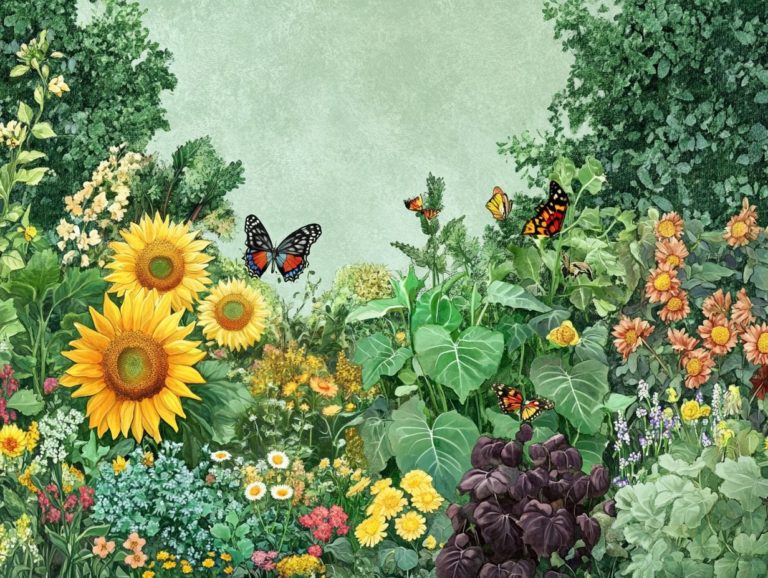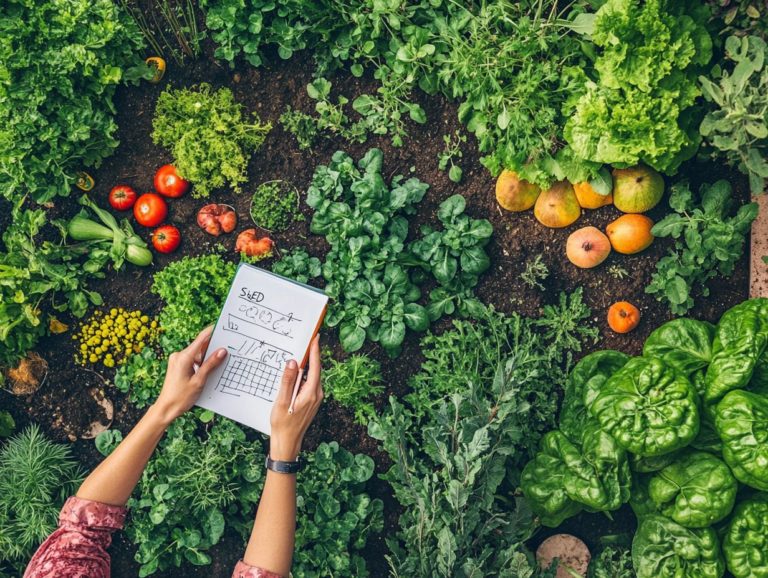Designing with Perennials in Permaculture
Permaculture and perennial design offer a sophisticated, sustainable way to garden and farm. This approach beautifully aligns with nature’s rhythms and invites the integration of elements like perennial plants and wildlife-friendly spaces.
Get ready to explore the exciting principles of permaculture! This article emphasizes the many benefits of incorporating perennial plants into your design. You ll uncover environmental and economic advantages, along with essential insights for selecting the right species based on soil type and sun exposure.
We provide tailored guidance on effective integration strategies and maintenance practices, ensuring your garden thrives.
You will find new ways to harvest and use your perennial plants, enhancing both your landscape and lifestyle.
Contents
- Key Takeaways:
- Permaculture and Perennial Design
- Benefits of Using Perennials in Permaculture Design
- Choosing the Right Perennials for Your Design
- Integrating Perennials into Your Permaculture System
- Maintaining Perennial Plants in Permaculture
- Harvesting and Using Perennial Plants
- Frequently Asked Questions
Key Takeaways:

- Permaculture principles guide the use of perennials in sustainable and regenerative design.
- Perennials offer numerous environmental and economic benefits in a permaculture system.
- When selecting and integrating perennials into your design, consider factors like climate, soil, and function.
Permaculture and Perennial Design
Permaculture and perennial design are essential for crafting sustainable ecosystems. For those interested in this approach, understanding the permaculture design process can significantly enhance your efforts. They not only boost the variety of plants and animals but also promote long-term soil health and storing carbon, which helps combat climate change.
By incorporating perennial plants into your garden design, you create wildlife-friendly spaces that are both visually appealing and ecologically functional. This method supports a layered planting scheme, allowing various plant types to flourish together harmoniously. For a deeper insight into this approach, consider exploring understanding permaculture design principles.
As you embark on your permaculture journey, understanding permaculture design: working with nature principles will lead to optimal results in both food production and maintenance practices.
Understanding the Principles of Permaculture
Grasping the principles of permaculture is crucial for creating a sustainable, self-sufficient ecosystem. In this ecosystem, every element harmonizes to enhance biodiversity and improve ecological function.
This holistic approach highlights the importance of ecological balance. It nurtures a vibrant mix of plant and animal life while fostering a resilient environment. Focusing on soil health is vital, as healthy soil brims with microorganisms that support plant growth and nutrient cycling.
By integrating perennial plants into your design, you create stable systems that reduce the need for frequent replanting and minimize soil disturbance. This enhances ecological function and cultivates environments that not only yield food but also contribute to long-term sustainability and fertility.
Benefits of Using Perennials in Permaculture Design
Incorporating perennial plants into your permaculture design brings myriad benefits that elevate sustainable growing practices. By using indigenous plants in permaculture design, these resilient plants enhance long-term soil fertility, significantly reduce the need for constant replanting, and foster wildlife-friendly spaces that nurture diverse organisms.
By cultivating a harmonious balance within the ecosystem, perennials can effectively minimize water usage and create resilient garden beds. Ultimately, this results in improved fruit production and crop cultivation as summer unfolds.
Environmental and Economic Advantages
The benefits of using perennial plants in permaculture practices are remarkable. They enhance the variety of plants and animals and offer a gardening approach that is resilient and cost-effective.
Perennials improve soil health by reducing erosion and enhancing nutrient cycling. Their deep root systems play a significant role in trapping carbon dioxide from the atmosphere, helping to combat climate change.
This sustainable practice conserves water. Perennials typically need less irrigation than annual crops.
From an economic perspective, lower maintenance costs lead to increased food production. This makes perennials a viable choice for home gardeners and commercial farms, especially when using organic pest control methods.
Investing in perennial plants allows you to cultivate a productive landscape while contributing to ecological conservation.
Choosing the Right Perennials for Your Design

Selecting the right perennials is crucial for creating ideal growing conditions. Consider factors like soil type and sun exposure, as they significantly impact which plants will thrive.
Native trees and shrubs enhance variety and foster a balanced soil ecosystem. This encourages healthy foliage and aids in carbon trapping.
Factors to Consider in Plant Selection
When selecting perennial plants for your permaculture system, carefully consider soil type, sun exposure, and growing conditions. These factors are vital for optimal growth and health.
Humidity levels and local climate variations also influence which species will thrive. Some plants enjoy humid environments, while others prefer drier conditions.
Evaluate the specific needs of each plant, including their water and nutrient requirements. These traits dictate how well they adapt to different ecosystems.
Choosing the right perennials means matching their needs with your environment. This fosters sustainable growth and enhances the resilience of your permaculture system.
Integrating Perennials into Your Permaculture System
Integrating perennials into your system requires a thoughtful approach. To enhance ecological function and the vitality of your garden, consider learning how to incorporate native plants in permaculture.
Employ effective planting strategies, like layered planting combining herbaceous and woody species such as perennial herbs and fruit trees. This cultivates a diverse ecosystem that supports local wildlife.
As you shape your garden, consider mulching and implementing crop rotation practices. These methods ensure long-term sustainability and create optimal growing conditions for your perennial plants.
Strategies for Incorporating Perennials
Incorporating perennials into your garden requires a thoughtful approach. Use diverse planting techniques that support nature and create inviting spaces for wildlife.
This strategy elevates your garden’s beauty and enhances biodiversity. Techniques like companion planting pair compatible species to improve soil health and deter pests naturally.
By diversifying your plant selections, you can attract beneficial insects, birds, and pollinators, contributing to a more resilient ecosystem.
As you observe these practices, you ll gain insights for sustainable gardening, transforming your garden into a thriving haven for a rich variety of life.
Maintaining Perennial Plants in Permaculture
Maintaining perennial plants in permaculture is essential for ensuring their longevity and effectiveness within your ecosystem. By implementing consistent maintenance practices such as pruning plants, deadheading flowers, and cutting back at the right times you can cultivate healthy foliage.
These practices establish a low-maintenance system that thrives. Understanding the specific needs of different perennial species and adjusting your care accordingly gives the power to you, creating a self-sustaining garden that flourishes year after year.
Caring for Perennials in a Sustainable Way

Caring for perennial plants sustainably is essential for nurturing healthy soil and promoting robust growth, ultimately paving the way for successful crop cultivation.
By embracing organic pest control methods like introducing beneficial insects or using natural repellents you can safeguard your crops while maintaining the delicate balance of the ecosystem. This ensures the robust growth of your perennial vegetables.
Opting for natural fertilizers derived from compost or plant matter enriches the soil, boosting its nutrient content and fostering a thriving habitat for microorganisms.
These practices enhance the resilience and productivity of your perennial plants while contributing to a more sustainable environment, allowing both flora and fauna to coexist harmoniously within your food forest.
In the end, implementing these sustainable techniques supports the long-term health of the land, creating a flourishing ecosystem that benefits everyone involved.
Harvesting and Using Perennial Plants
Harvesting and utilizing perennial plants in your permaculture system will boost both food production and sustainability. The varied selection of perennial vegetables, herbs, and fruit trees allows for harvesting at different times, ensuring a steady flow of fresh produce throughout the growing season.
By mastering propagation techniques and employing the appropriate harvesting methods, you can maintain a thriving garden that supports nature and enriches your culinary adventures.
Ways to Utilize Perennials in Your Permaculture System
Utilizing perennial plants in your permaculture system opens up a world of opportunities for enhancing food production while seamlessly integrating sustainable practices into your daily life, as understanding the role of design in permaculture gardening can greatly benefit your efforts.
These resilient plants offer a continuous supply of nutritious food and demand far less maintenance than their annual counterparts. This allows you to savor the rewards of your efforts with minimal fuss. Many perennials, like asparagus and rhubarb, can be harvested season after season, making them fantastic additions to your culinary repertoire while championing ecological stewardship.
When you incorporate these plants into your landscaping, they contribute to soil health and promote biodiversity. This fosters a resilient ecosystem. The presence of perennials also stabilizes soil, reduces erosion, and supports pollinators, bringing both visual appeal and functional advantages to your garden.
Frequently Asked Questions
What are the best perennial plants for beginners?
How can I maintain my perennial plants sustainably?
What benefits do perennials provide to my garden?
What is permaculture?
Permaculture is an ecological design system. It focuses on creating sustainable and self-sufficient habitats by imitating natural ecosystems.
What are perennials?

Perennials are plants that live for more than two years. They can regrow after their above-ground parts die back each year.
How can perennials be incorporated into permaculture design?
Perennials provide food, shelter, and resources for people and wildlife. They also improve soil health and prevent erosion.
These plants can be integrated into a food forest or grouped together in a way that benefits each other, known as a guild.
What are some examples of perennials that are commonly used in permaculture design?
Commonly used perennials include fruit trees, berry bushes, and perennial herbs. Nitrogen-fixing plants like legumes and edible perennials such as asparagus and rhubarb are also great choices.
How do perennials benefit the environment?
Perennials have deep root systems that improve soil structure and fertility. They also provide habitat and food for pollinators, contributing to a diverse and resilient ecosystem.
What are some tips for designing with perennials in permaculture?
When designing with perennials, think about the specific needs of each plant. Consider integrating natural patterns in permaculture design and plan for a mix of early, mid, and late-season plants to ensure continuous harvests.
Incorporating perennial polycultures can maximize the benefits of these plants in a single space, enhancing overall productivity.






